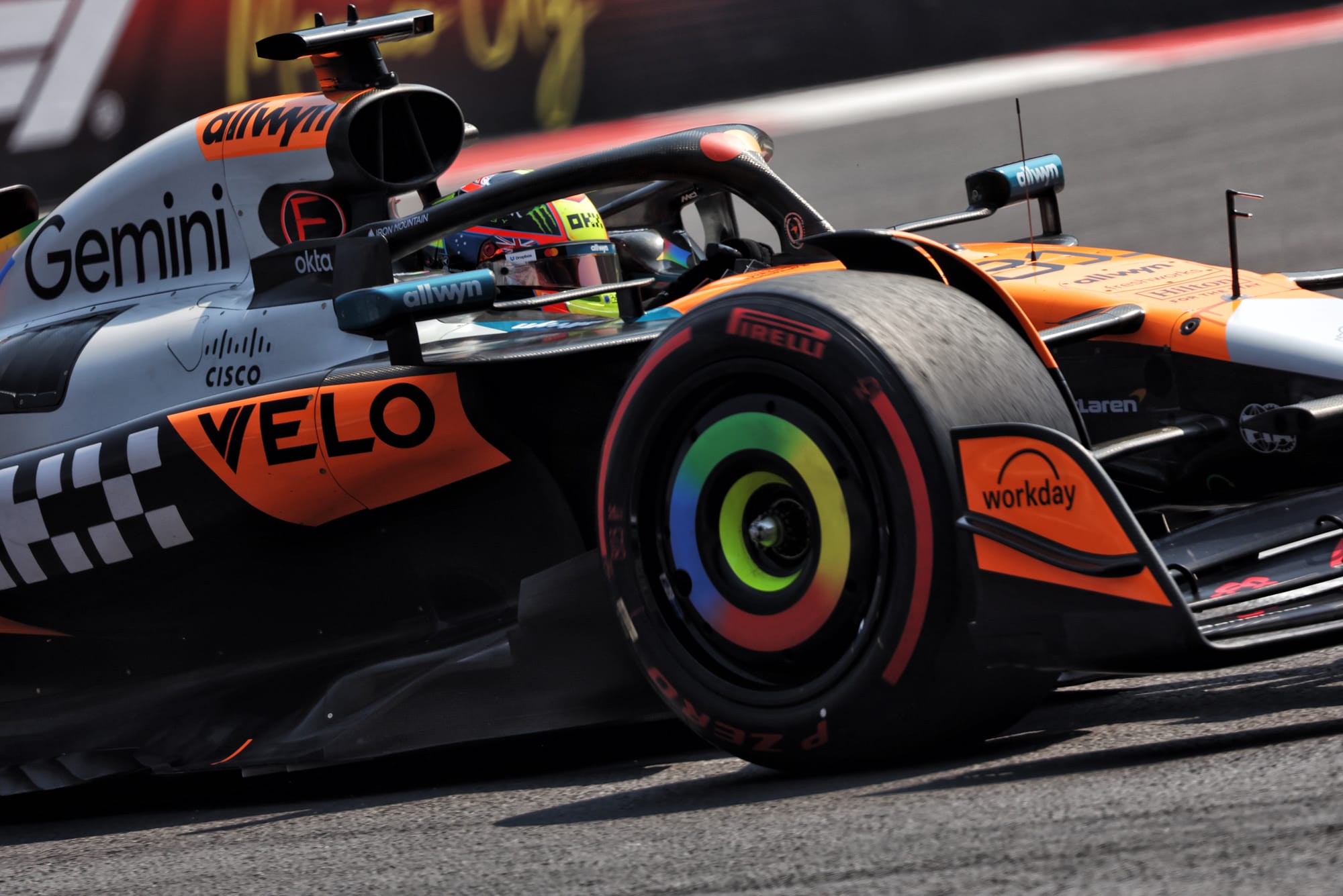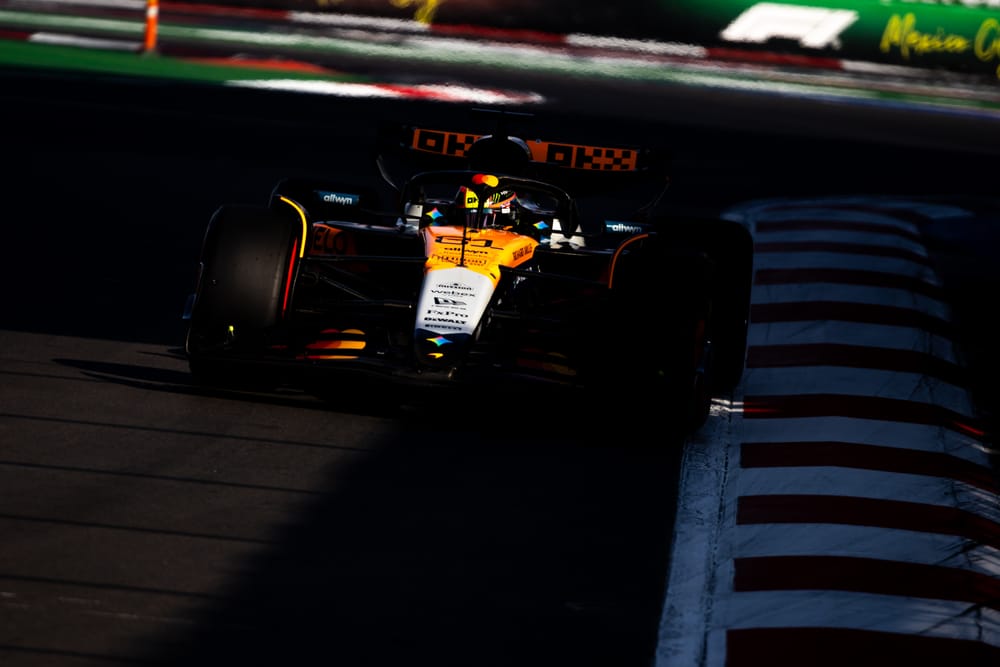Oscar Piastri's "mystery" lack of pace in qualifying for the Mexican Grand Prix means he faces the possibility of losing his Formula 1 world championship lead for the first time since April in Sunday's race.
This wasn't a case of a blunder costing him time in Q3, or obvious mistakes accumulating, but reflects the very clear pattern through the whole weekend: he is simply slower than McLaren team-mate Lando Norris.
Piastri lapped 0.588s off Norris's pole position time and will line up seventh for the race thanks to Carlos Sainz's five-place grid penalty. While he was puzzled by the deficit, Piastri accepted it was in keeping with the pattern of the entire weekend. He was six-tenths slower than Norris in the two free practice sessions both ran in, with the gap in Q1 and Q2 0.259s and 0.485s respectively. You can also extend this to the United States GP last weekend, where Piastri was also off the pace.
So what's the problem?
With both drivers understood to be on similar set-ups, the first possibility to consider is whether there might be some underlying car problem, perhaps some undetected damage carried over from the first-corner collision in the Austin sprint race last week. Piastri didn't rule this out, and reading between the lines you might even conclude he's hinting at it, but he also said the overall feel of the car was normal even though he was at times visibly struggling for grip compared to Norris.
"Difficult to know," said Piastri when asked by The Race if he was sure there was nothing wrong with the car. "Everything feels normal, but the gap was big in that session, it's been big all weekend.
"There's been some things where I felt like I can tidy it up and make some easy progress, but not all of it. And I think in qualifying I did a reasonable job and the car felt reasonable as well. So the lack of laptime is a bit of a mystery."
McLaren team principal Andrea Stella was asked whether a change of monocoque might be required, but was confident Piastri's car is working as it should do. That doesn't completely rule out the possibility something has been found, but makes it unlikely.
"Every evidence, every piece of data, every indirect measurement of information we have tells us that there is no problem with the car, and we have no reason to suspect that that's the case," said Stella.
"Also the change of the chassis, I know that in the history of Formula 1 there is this topic of changing the chassis. I would change other components than the chassis, like the floor, the front wing, but in reality, there's a rotation of parts, so it's not like there's always the same parts on the cars. So we have reasons to be reassured that there's no problem with the car."
Stella instead said he believes the answer lies in Piastri's driving technique, which has generally been extremely successful but has not proved entirely suited to the sliding and low-grip conditions both at Austin and in Mexico. While Norris, more in tune with those demands but who has had his troubles elsewhere, proved the McLaren was the class of the field over a single lap, for Piastri it was more difficult. Stella summed it up as Norris excelling in low grip, Piastri in high grip.

"The fastest car is a car that needs to be driven in a certain way, especially when you have conditions like here, and to some extent in Austin, with hot Tarmac, sliding tyres," said Stella.
"And the way in which you generate laptime is a way that comes relatively naturally for Lando, and less naturally for Oscar. Lando is the driver of going on low grip, end of the stint when the tyres are quite worn, the grip is low - it's where we see Lando go green sector, green sector, green sector. Oscar, instead, is more of a driver of high grip. That's where he can exploit this incredible talent.
"At the same time, we don't have to forget that while we talk about the leader in the drivers' championship, he's not even finished the third season in Formula 1. So experiencing situations like we have here and in Austin is how you actually calibrate yourself as a driver. Every session is learning a little bit as to what you need to do, what you need to feel, to say, 'I'm fast now in these specific conditions', which, conversely are more natural conditions for Lando.
"So nothing to worry [about]. I think it's more a calibration exercise for Oscar. I'm sure this calibration will pay off already in the race and in any future event in which the regime in which the tyre and the car interact with the Tarmac is similar to here."
Prior to running in Mexico, Piastri suggested his troubles last weekend were specific to the Circuit of the Americas. But during FP2, there was already a hint that there was something in common with the difficulties when race engineer Tom Stallard updated Piastri on Norris's pace advantage, suggesting that the edge in the heavy braking zones at Turn 1 and Turn 12 were key to that and saying "he's challenging the braking and rear slips more, a bit like Austin but a smaller difference".
This relates to something Stella said last weekend about the importance of maximising the efficiency of the brakes to deliver laptime. That proved difficult for Piastri in the low-grip conditions at Austin, as well as Mexico.
"In some ways, not too dissimilar," said Piastri when asked how different his problems in Mexico were to those in the US. "What's been a bit surprising here has just been that the gap's been the same pretty much every session. I feel like I've done some decent laps through the weekend, but everything seems to be about four or five tenths off. That's obviously not a great sign, but some of the things that were difficult in Austin are also proving difficult here.”
Piastri can be mighty on the brakes, notably when throwing the car into hairpin turns, but one of the themes as he worked on his technique through the Mexico weekend has been experimenting with braking points and, at times, trading off peak pressure with elongating the braking zone.
On his final Q3 lap he braked a little later than Norris for Turn 1, but had lost around half a tenth by the first apex. He couldn't carry the same speed through Turn 2 as his team-mate and the losses through the right/left/right sequence, and his inferior exit, added up to a deficit of around two tenths by the time he got to Turn 4.
The Turn 4-6 sequence had been a problem for Piastri earlier in the weekend, but by Q3 he was more in tune with it and actually pulled some time back to make the gap just under a tenth and a half entering the fast sweeps of Turns 7-11. Despite Piastri typically being strongest in high speed corners, this is a section where Norris had a clear advantage throughout the weekend, building his advantage to almost four and a half tenths by the entry to Turn 12, which follows a short straight after the sweepers.
Piastri carried less speed than Norris through and out of Turn 10/11 on his final lap, then lost a little more time through the stadium complex, as has generally been the case this weekend. Not controlling the rear tyre temperatures as well as Norris appeared to play a part in that.
Piastri characterised it as "losing a little bit everywhere" and while laptime loss is rarely uniform across the lap it has been consistent. There's been no corner or corner sequences during practice and qualifying where Norris hasn't been the quicker driver, and that could potentially be explained by an underlying car problem.
However, it could also be an aggregation of small deficiencies against a team-mate who is on mighty form, with Stella summarising it as "one driver is struggling a little bit and the other driver really managed to perform at the best of what was available".
Given how effective Piastri has been at stepping up his performance during weekends in 2025, though, and excelling at tracks where he'd struggled last year, it's understandable that he's confounded by the fact he hasn't been able to turn things around.
"From Austin, there was some things that were clear, but even those things that were clear were a bit unusual, some of the differences," said Piastri.
"And again, this weekend it's been a bit different; I've not changed really how I'm driving since the start of the season - even a few races ago when things were going really well. So, it's difficult to pinpoint where the laptime's been lacking this weekend, but I'm sure we'll find it."
Stella said there are reasons why this trouble has not reared its head prior to this late stage of the season. Mexico appears to have provided a unique combination of a soft C5 tyre without any graining, for example, which is very different to last year, and has created what Stella called a "quite particular regime" to manage the preparation and execution of a qualifying lap.
But it's not just about qualifying because so far this weekend, Piastri's long-run pace has also looked weak relative to Norris. And even if he does make a big step on Sunday, gaining track position in what is expected to be a processional one-stop race with the emphasis on managing the car temperatures, it will be difficult to make big positional gains.
That makes Sunday's race all about damage limitation. But regardless of how that plays out there's every reason to expect that when he returns to action at Interlagos for the next race, Piastri will be back to normal and every bit the championship threat.



